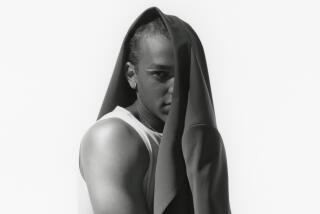Trapped by the Dress-Up Gene
Those who cannot remember the past are condemned to repeat it. --George Santayana
Honey, I don’t care what your cousins are wearing . --Alice’s Mom
Any parent presumably knows the rules for dressing a little girl.
Rule No. 1: Little girls--like little boys--should wear clothes that are pre-stained, preferably in shades reminiscent of Chef Boy-Ar-Dee products.
Rule No. 2 (for the wimpy parent): Little girls should be allowed to wear whatever they want: cowboy boots, tutus, “101 Dalmatians” underpants. Together. Or separately.
Rule No. 3: Never expect to hear your daughter say: “Hey, Mom and Dad, I’d like to wear the pink cotton smocked dress. You know, the one with the big fussy bow that hurts my back when I lean against a chair. And let’s top it off with the matching hat, the one with the elastic strap that cuts off the circulation in my neck.”
Most men don’t seem to have any difficulty with the rules. I can’t say the same for some of the women who bear their children.
Consider the case of 6-month-old Madeline. Her mother prefers black stretch pants, mismatched earrings, and tights that look as if they came off the set of “Shindig.” But on any given day, you’ll find Madeline drooling all over a white gown of tissue-paper-thin cotton decorated with antique lace. Or a pink cotton dress starched to perfection and topped with a white, lace jumper. Or a quilted satin romper with a matching jacket covered in pink satin bows.
I should know.
I’m the dresser.
August, 1961: I sit on the steps leading to my grandfather’s porch in southwest Missouri, surrounded by many cousins. They are short, compact, blond and athletic. I’m not. They are all dressed in shorts and sweaty T-shirts. Their socks and sneakers are muddy. Clad in a sun dress, Mary Janes and anklets, I suffer my humiliation in silence. But that’s OK with the Short clan. All the better to hear themselves chanting my new nickname :
Alice the Goon.
I suppose I was allowed to wear jeans and sweat shirts as a kid. I couldn’t possibly have worn my red velvet dress to kindergarten every day. And I guess there are photographs of me in which I’m not wearing white kid gloves and a straw hat.
But it sometimes seems as if I spent my entire childhood modeling for an Easter layout in a J.C. Penney catalogue.
I wore cotton velveteen; my playmates wore denim. When friends played bareheaded in the snow, my head was swathed in a red, white and blue knitted cap--with matching mittens, of course.
It never occurred to me that my mom acted out of love. I just wanted to be like everyone else.
And I swore that if I ever had a little girl, I’d never perpetuate the dress-up tradition.
So why is my daughter wearing a pale green linen dress with jillions of tiny pearl buttons that cascade down the back?
And a matching slip?
August, 1962: I sit on the stoop in front of my great-aunt Adele’s St. Louis home, surrounded by my parents and various aunts and uncles. Looks pretty normal, pretty early ‘60s. Right down to the handmade mother - daughter dresses. But wait, there’s more. Chatty Cathy is wearing a dress of the same fabric. And my dad--a Marine Corps colonel!--is sporting a short-sleeve shirt of this very same material.
And he’s smiling.
Yeah, we’re all smiling. Especially my grandmother’s sisters. And why not? They never had to wear mother-daughter dresses.
Charles Weinstein, a child psychologist in Encino, says this tendency to engage in the behavior of our parents can sometimes be regarded as “repetition compulsion.”
It’s “when we do things that aren’t necessarily good, but we are drawn to them because (our parents) have done them. Like people who get into bad relationships. . . . Like men who are fairly liberated, but sit down with their sons with a can of beer and belch and talk about broads.
“It’s something that was instilled fairly early on.”
Some friends who have fallen victim to the Overdressed Daughter Syndrome have their own theories. “It’s the playing out of the fantasy of what it means to have a little girl,” says one. “Some of the gifts my daughter got were the most uncomfortable clothes in the world, but that’s what she wore when it came time to take the pictures. Those are the memories we want.”
For my friend Laurie, it’s all a matter of living vicariously.
“I’m never pulled together,” she laments. “I’m the one getting the kids dressed. So when (my daughter) looks pulled together, it’s the part of me that never is. Most mothers believe that the way the kids are dressed is a reflection of being a good parent.”
My theory?
It’s genetics.
March, 1968: My best friend, Barbara, and I are perfecting the art of looking sullen as we pose in identical uniforms of plaid skirts, white blouses and V-neck sweaters. Our mid-knee hemlines are tragically long, but our 14-year-old brains--and our purses--are full of the stuff to sully our schoolgirl image.
Before our walk to school is over, our skirts will be about 6 inches shorter (rolled at the waistband), and our eyes will be rimmed in black eyeliner and Maybelline midnight blue mascara. My package of Tareytons will be missing two cigarettes.
We don’t inhale, but it doesn’t matter. No one would ever assume our moms helped us get dressed that morning.
My mom, of course, gets the last laugh. Not only am I dressing my daughter as my mother once dressed me, but I’m starting to dress like my mom.
Or maybe she’s starting to dress like me.
At first glance, our closets bear little resemblance, but we seem to be acquiring the same shoes and sweaters. Can total twinness be far behind?
“Madeline,” I think, “I’ve been tricked. But I’m not sure I care.”
That would be Madeline . . . my mother . . . my daughter’s namesake.
Must be the genes.







